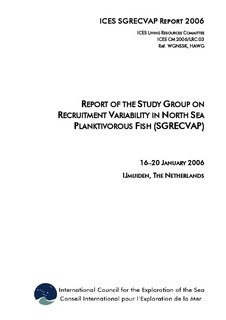| dc.description.abstract | The poor recruitment in recent years (2001–2004) in planktivorous fish in the North Sea has become cause for concern for fishers, managers, and scientists alike. It has lead to fishery closures and cuts in total allowable catches in sandeel, Norway pout, and herring. SGRECVAP met to investigate and describe the serial poor recruitment, and review probable mechanisms for the recruitment trends.
Time-series analysis showed that there was a common trend in the recent recruitment of all three target species. There was a strong negative trend in the stock-recruit residuals for herring and Norway pout, suggesting that the poor recruitment in those stocks is not related to spawning-stock biomass size. This was not the case in sandeel, where the situation was more complex. The common pattern of decline in recruitment seen in the planktivorous fish was not common to the major commercially exploited fish species in the North Sea. There was evidence for significant shifts of at least two periods of recruitment for the major commercial fish species exploited in the North Sea (1986 and 1996/97). Specifically for the three target planktivorous species, SGRECVAP considered there was a significant shift in recruitment in 2001.
There was enough evidence to conclude that poor recruitment in herring was caused by a higher mortality of herring larvae before February of each year. The mechanisms for this were most likely poor larval feeding, predation or poor hatching condition and probably a combination of these. There was evidence that higher mortality of herring larvae can co-occur with high larval production.
Whilst herring, Norway pout and sandeel showed a common trend in recruitment, it cannot be assumed that the same mechanism was common for all three species. Owing to insufficient information on the production of each life history stage in Norway pout and sandeel it was not possible to determine the mechanisms driving recruitment. It was clear that the poor sandeel recruitment from 2002 occurred at low spawning-stock biomass (the stock was below Blim in 2000); this was not the case for Norway pout. A well documented change in the planktonic community occurred in the North Sea after the mid 1980s. Change has continued to date, on a gradual basis, and is linked to the broader process of climate change/variability. Reponses at other trophic levels to this gradual change in the zooplankton may result in abrupt changes.
More exploration is needed to investigate the hypotheses presented in the report particularly targeting ecosystem interactions, especially in zooplankton (combined with hydrographic variability), predation, and quality/condition of adults, eggs, and larvae. The Study Group on Recruitment Variability in North Sea Planktivorous Fish (SGRECVAP) acknowledged that many of the proposed hypotheses could not be tested without extensive use of empirical data and individual and ecosystem modelling (biophysical models and spatial trophic modelling). | en |
